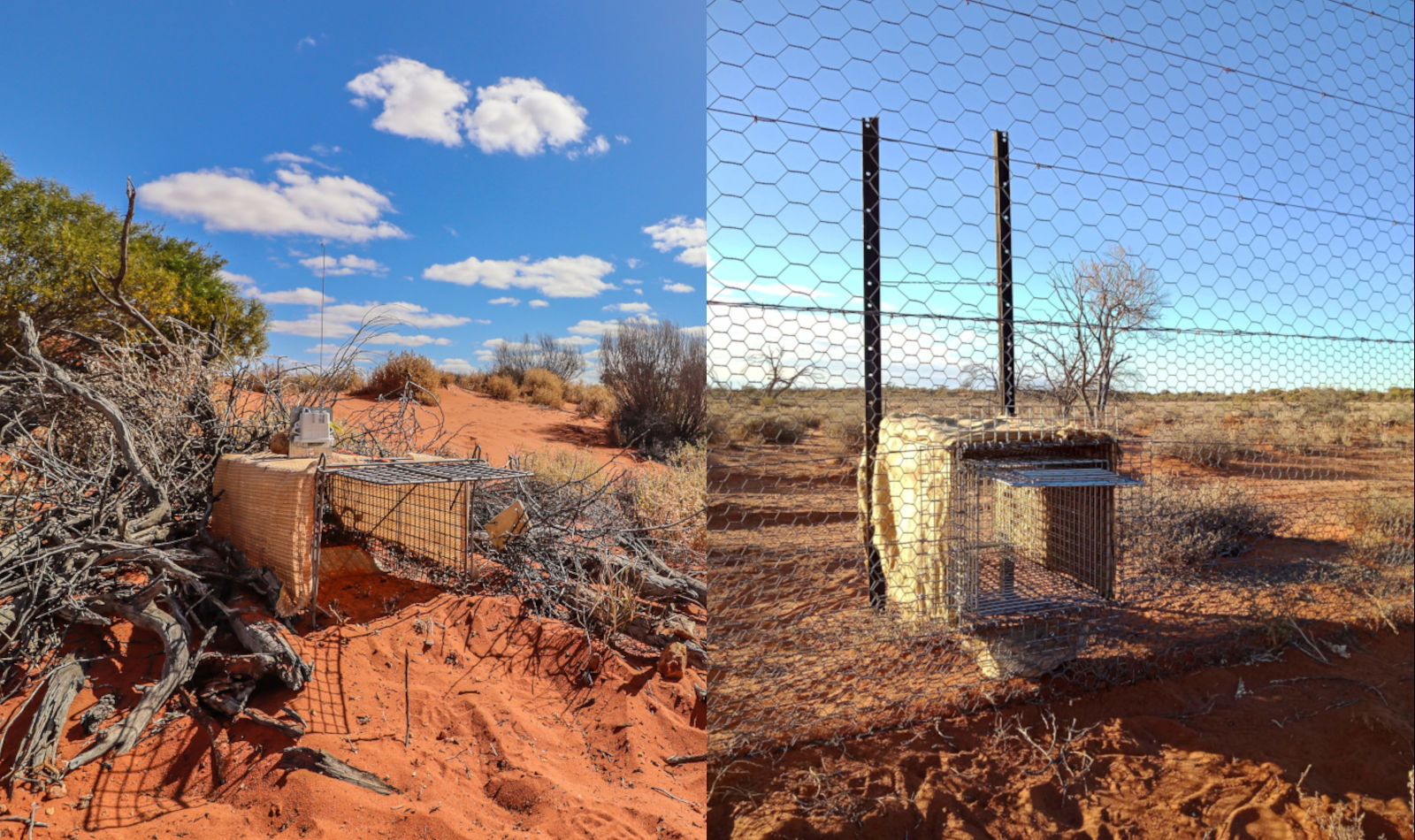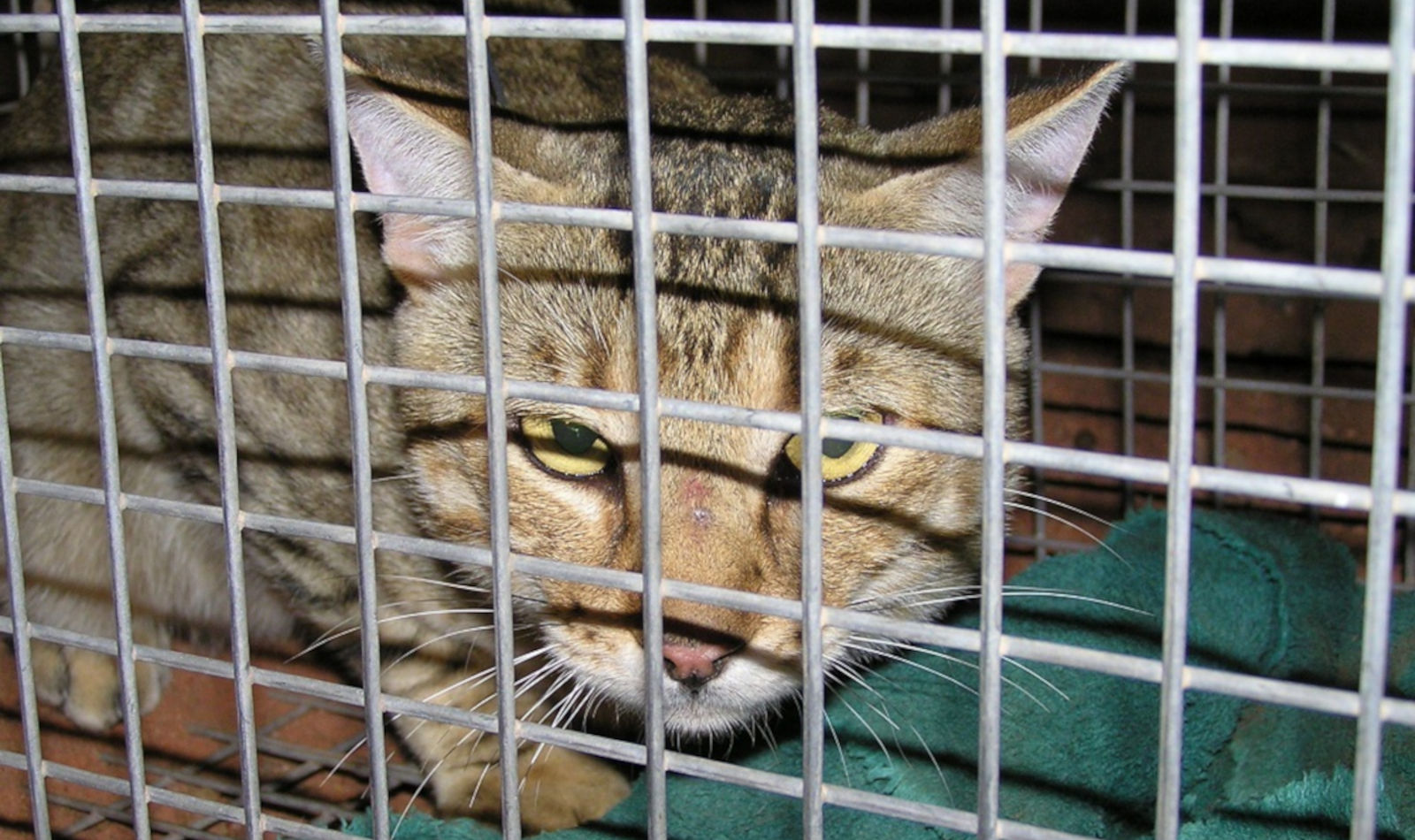Controlling Feral Predators
In the arid zone, one-third of the original native mammals have disappeared from the landscape. Feral cats and foxes have been the main contributors to most of these extinctions
_I-Badman-(2)-1600x800.jpg?lang=en-AU)
Effective control of feral cats, foxes, and rabbits beyond Arid Recovery's fence is crucial for safeguarding the reserve from incursions, and for fostering the potential reintroduction of vulnerable wildlife into the wider landscape
Controlling feral animals outside the reserve enables small mammals and reptiles to move beyond the fence, and reduces the likelihood of feral animal incursions into the reserve. Arid Recovery employs a combination of trapping, baiting, and shooting to manage feral animals around the reserve, and has also trialed new technologies to enhance control efforts.
Trapping
Arid Recovery has a permanent set of cat and fox traps surrounding the reserve, equipped with Celium trap alert system from Encounter Solutions. Each trap has a node, that when the trap closes, an email and text message are sent to our conservation land manager. This allows us to respond quickly, minimising the time animals spend in traps and improving their welfare. This system has been very successful, enabling us to remove 81 and 177 cats in 2022 and 2023, respectively.
In 2018, Arid Recovery installed a series of 'breach traps', and are now connected to the Celium trap system to ensure rapid responses to animal captures. These breach traps are permanently built into the fence, raised about 50 cm above the ground, and unbaited, targeting animals trying to enter the reserve. So far, they have been effective, capturing several large feral cats.
 A cage trap set outside the reserve with the Celisum node system attached (left), and a breach trap set in the fence (right)
A cage trap set outside the reserve with the Celisum node system attached (left), and a breach trap set in the fence (right)
Lures
We have trialled many lures for cats and foxes. We have found the most effective lures are cat urine and chicken oil. Fried chicken has also worked well. We have also used electronic devices that make a meowing noise (made by Westcare).
 A cat lured into a cage trap using cat urine
A cat lured into a cage trap using cat urine
Shooting
We have a team of dedicated volunteer shooters because some feral cats and foxes are too cautious to enter traps. Shooting is essential for removing these elusive animals. In 2023, shooters removed 322 feral cats from around the reserve's perimeter. If you are from the local community and interested in helping control feral animals, please contact us to volunteer.
Baiting
Poison baiting for foxes and cats is widely used across Australia. Foxes readily take meat baits, making this method very effective for controlling their population. However, these baiting programs need to cover large areas to prevent new animals from moving in. Large-scale operations like Bounceback in the Flinders Ranges have been remarkably successful, as they cover many properties and parks throughout the region.
Eradicat and Curiosity are poison baits specifically designed for cats. These baits are smaller, have a scent that attracts cats, and contain a cat-specific toxin, often within a small capsule. This design increases the chances that only cats will be affected by the bait. Cats typically swallow food whole, including the capsule, while native animals that chew their food usually find the capsule and spit it out.
Eradicat and Curiosity baits have been trialed at Arid Recovery. Despite testing different baiting densities, frequencies, and areas over a five-year period, a successful long-term strategy for controlling feral cats with Eradicat baits could not be developed. Baiting is only effective when cats are hungry. When there is an abundance of live prey, cats are rarely hungry and therefore unlikely to be interested in baited meat.
Despite these issues, cat baiting is still a valuable tool. It can be used in a targeted way to reduce cat density at critical times, when most cats are hungry. Baits can also be an effective means of controlling cats around dumps, as these cats are more used to scavenging. Cat baits continue to be refined and tested so we can expect them to be more effective over time.
Felixer cat grooming trap
The felixer cat grooming trap uses laser sensors and arttifical intelligence to target feral cats and foxes. When a feral animal is detected, the Felixer sprays a dose of toxic gel that the animal ingests while licking its fur clean. This innovative trap was developed by John Read, one of the founders of Arid Recovery, from Ecological Horizons and commercialized by the Australian not-for-profit company Thylation.
.jpg?lang=en-AU) A solar-powered felixer ready for action at Arid Recovery
A solar-powered felixer ready for action at Arid Recovery
The solar-powered machines use an array of range-finder sensors and artificial intelligence to distinguish cats and foxes from other wildlife, humans, and vehicles. When a cat or fox is identified, the Felixer sprays a measured dose of toxic gel. The system then resets, ready for another firing, and can hold up to 20 gel cartridges.
The advantage of this system is its target-specific approach, leveraging feral cats' meticulous grooming habits. As the animals groom themselves, they ingest the toxin. This method significantly improves upon traditional techniques, overcoming cats' reluctance to take baits and eliminating the need to frequently check and re-bait traps.
The felixer is an innovative, humane, and automated tool designed to manage and decrease the population of feral cats and foxes, ultimately improving the welfare of native wildlife
 Cats and foxes fired upon using the felixer During a six-week trial at Arid Recovery, twenty felixer traps were tested. Notably, none of the 1024 non-target objects, including bettongs, bilbies, birds, lizards, humans, or vehicles, triggered the Felixer traps. Of the 43 cat detections recorded, 77 % were accurately identified as targets and fired upon by the Felixer traps. Cats that were not correctly identified as targets were either walking in a non-perpendicular direction to the firing mechanism or were crouched in front of the trap, thus not meeting the identification algorithm's criteria.
Cats and foxes fired upon using the felixer During a six-week trial at Arid Recovery, twenty felixer traps were tested. Notably, none of the 1024 non-target objects, including bettongs, bilbies, birds, lizards, humans, or vehicles, triggered the Felixer traps. Of the 43 cat detections recorded, 77 % were accurately identified as targets and fired upon by the Felixer traps. Cats that were not correctly identified as targets were either walking in a non-perpendicular direction to the firing mechanism or were crouched in front of the trap, thus not meeting the identification algorithm's criteria.
The felixer has been approved by the federal authorites for feral cat managment across the country.